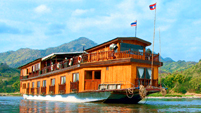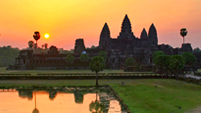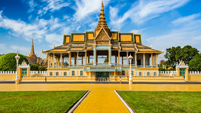Quick Facts:
Preah Vihear temple, which is located atop 525 meter cliff in the Dangrek Mountains, in the Preah Vihear province, Cambodia, is an ancient Hindu temple built during the reign of Khmer Empire. In the 6th century, king Yasovarmamn I began on the original dedicated to Shisa as a result of spiritual development,increased political prestige and economic growth was naturally reflected in the Temple undergoing more than 300 years of consultation with deal of remodeling under subsequent King Suryavarman II.
After a long time of dispute between Thai and Cambodian, under the Franco-Siamese Treaty of 1904 and 1907, the line of frontier between Cambodia and Thai along the Dongrak Mountains followed justice at the Hague officially found that the PreahVihear Temple situated inside the Cambodia territory. Moreover, the PreahVihear temple is also recognized one ofUNESCOs World Heritages as by the World Heritage Committeeon 8 July with the addition of 19 cultural sites and eight natural sites to the List.
PreahVihear is outstanding among Khmer temples in being constructed along a long north-south axis, rather than having the conventional rectangular plan with orientation toward the east. The temple extends around 800 m along a north-south axis facing the plains to the north, from which it is now cut off by the international border. It consists essentially of a causeway and steps rising up the hill towards the sanctuary, which sits on the clifftop at the southern end of the complex (120 m or 390 ft above the northern end of the complex, 525 m or 1,722 ft above the Cambodian plain and 625 m or 2,051 ft above sea level). Although this structure is very different from the temples found at Angkor complex, it serves the same purpose as a stylised representation of Mount Meru, the home of the gods.
The temple has four levels and four courtyards which comprise of five Gopuras.
Palace Building on the third level: This group of building was the King's residence when he came to pay homage to the mighty God, and the two wings were the shelters for the pilgrims. The main temple is used for the high-ranking supreme divinities; this mighty group of building is considered as the center of the whole temple complex.
The front stone stairway: this main passage is on the North side. The stairway is 8 meters wide and 78 meters long. The first flight has 162 steps. At the first landing is a large stone singa statue on stone block. Another 54 flight of steps 4 meters wide and 27 meters long leads up to the second landing also decorated with stone signa statue.
The NagarajCourtyard : this stone-paved is 7 meters wide by 31.8 meters long. From here the stairway leads up to the first-level Gropura. The Stairheads are in the form of seven-headed snakes called "NguSuang " facing North towards the Prasat. The heads and tails of nagas on both sides look like ordinary snakes, characterizing and early example of this type of animal figures. The head portion of the naga on the west side looks very impressive because it is made from a single solid stone.
The first level Gopura : this is a pavilion in Greek architecture style with cross plan on an elevated, rebates angle base on each of the roof doorway . Stone lions are placed on each of the roofs doorway.
There are many different ways to reach the PreahVihear Temple. Tourists can approach by crossing the frontier between Cambodia and Thailand from the Ubon Ratchantani Province of Thailand. From Cambodia, the temple can be approached either by Tbeng Meanchey in Preah Vihear province or from Siem Reap in Siem Reap province via AnlongVeng. Although the highway is paved when it leaves Siem Reap, both roads are graded gravel once they begin to approach the Dangrek escarpment.







































